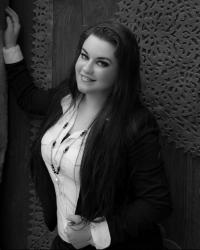
Biography
Christine Şahin is a dance practitioner-scholar and ethnographer specializing in contemporary Egyptian raqs sharqi (“belly dance”) and other MENAT (Middle Eastern, North African, and Turkish) dance genres. Her research focuses on interweaving dance, performance, and Middle Eastern corporeality studies through creative ethnography and choreographic and embodied writing. Şahin has a Ph.D. in Critical Dance Studies from the University of California, Riverside, and a Bachelor of Arts in Anthropology from the University of Delaware. She has professionally performed and taught raqs sharqi and other MENAT dances throughout the East and West coasts for over fifteen years. She also specializes in geriatric fitness and mind-body wellness. Her research has been published in Kohl: A Journal for Gender and Body Research.
Şahin’s book, Core Connections: Cairo Belly Dance in the Revolution’s Aftermath, published with Oxford University Press (2024), investigates local, intra-Middle Eastern, and global circulations of raqs sharqi centered within Cairo, Egypt, in the tumultuous aftermath of the Jan. 25th, 2011 revolution. This multi-sited ethnography takes audiences on a taxi ride that viscerally moves through contemporary city-circuitries of dance venues and stories from the Nile cruising tourist boats and decadent five-star hotels to smoky late-night discos and Pyramid Street cabarets. While mapping the multiple maneuverings of Cairene dancers and non-dancers alike, this book centralizes Cairene dancers embodied political insight while fleshing out nuanced portraits of their lives and stories amidst ongoing political precarity. In addition to interweaving Dance and Middle Eastern Gender and Corporeality Studies, this book innovatively does and writes ethnography. This book’s ethnographic approach embodies the dance itself via attending to the dual meanings of moving; centralizing mobility and movement as sites of power and knowledge, but also in researching and writing in ways that move emotionally, stirring up poignant affect that leads to physical reaction, change, and connection. In other words, this ethnography aims to center the same aesthetics and values of Cairo raqs sharqi, to ‘move’ with greater feeling to cultivate richer core connections within ourselves, between one another, and within our city-spaces. In doing so, this book stakes a claim for listening to the subtleties of otherwise marginalized bodily interaction, exchange, and wisdom as rippling with potential for stepping into more revolutionary realities and relationships.